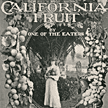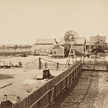
 |
 |
||||||||
|
|
Lessons Menu - Lesson 9 - Lesson 10 - Lesson 11 - Lesson 12 - Lesson 13 - Lesson 14 - Lesson 15 - Lesson 16 |
| Lesson Plan 16 - Agriculture INTRODUCING THE AGRICULTURE GAME |
download
lesson16.pdf |
|
| OVERVIEW STUDENT OBJECTIVES CALIFORNIA HISTORY STANDARDS STUDENT
ACTIVITY SHEET 16 AND KEY: My Farm Visit Journal (includes
Aunt Sarah's Recipe) |
ADDITIONAL ITEMS AVAILABLE IN THIS LESSON PLAN: |
|
DOCUMENTS TO DISCUSS
(view online or print screen) |
||||
 download pdf file |
1. Eat California
Fruit [1904] Illustrated pamphlet describing the wonders of California fruit, includes recipes. (Large PDF File - 3.7 MB) |
 view large image |
2. Hack ranch in Freeport [ca. 1890] View of yard around farmhouse, showing barn, other outbuildings, areas fenced off in sections, horse-drawn wagons, and windmills; orchard in distance. |
|
|
INSTRUCTIONS 2. In this activity, students play the Agriculture Game at http://www.sacramentohistory.org. (Choose Agriculture Game from the Games menu at the top of the screen). 3. Before introducing the game, you may want to review and print the two documents above. Document 1 is a pamphlet from 1904, which provides additional background about agriculture and food in that time period. Document 2 is an image of a family farm in the 1890s. 4. In the game, students make an imaginary visit to their aunt and uncle’s farm in the Sacramento Valley. Although set in the early 1900s, the events and activities shown are typical for any family farm without electricity and refrigeration, from the 1880s through the 1920s. Featured areas on the farm include the following: |
a. Farmhouse kitchen |
|
b. Henhouse |
|
c. Barn |
|
d. Almond orchard |
|
e. Almond hulling shed |
|
f. Garden |
|
g. Cistern |
|
h. Additional images
include a railroad depot, exaggerated postcard, |
| Sacramento History Online © 2003 - 2004 | |